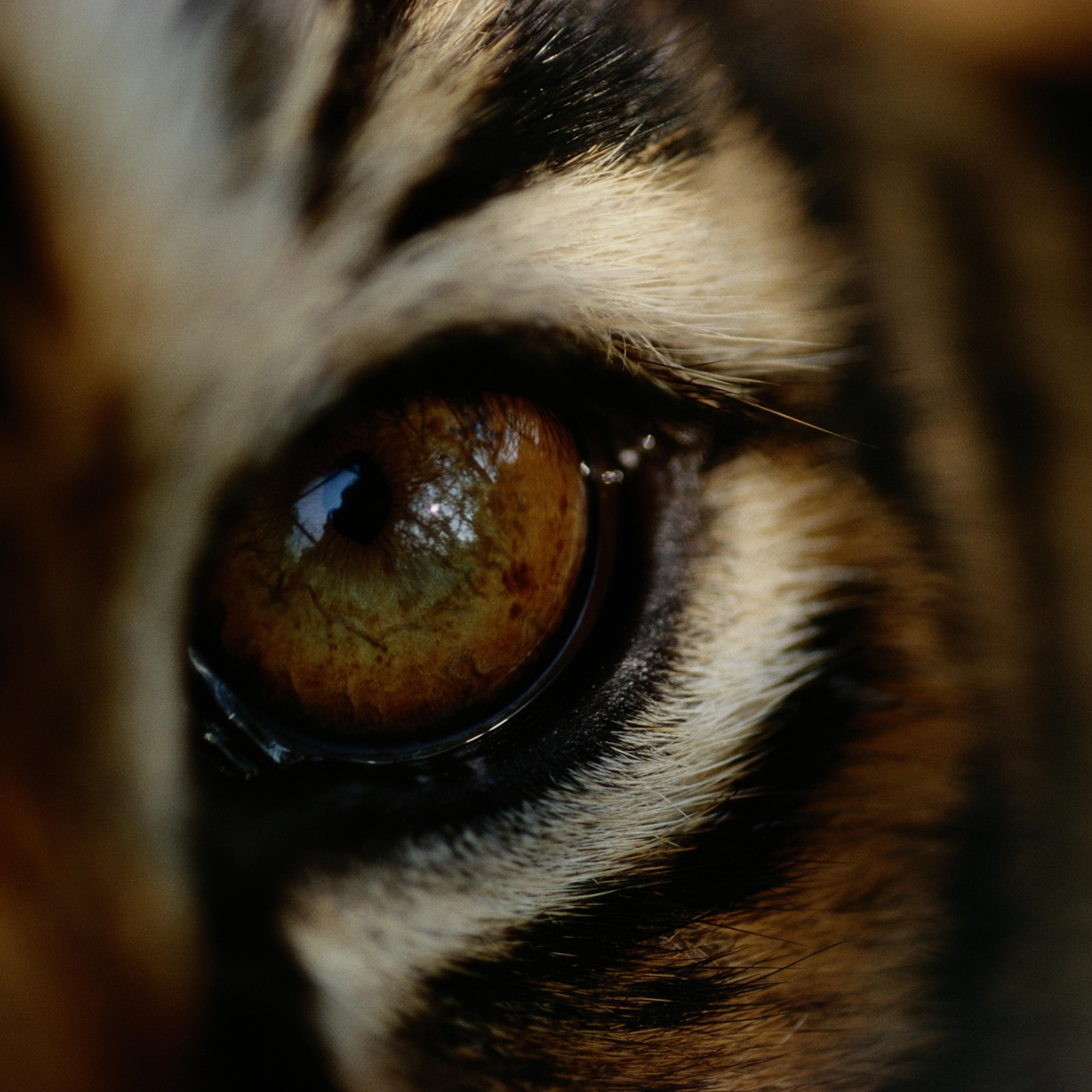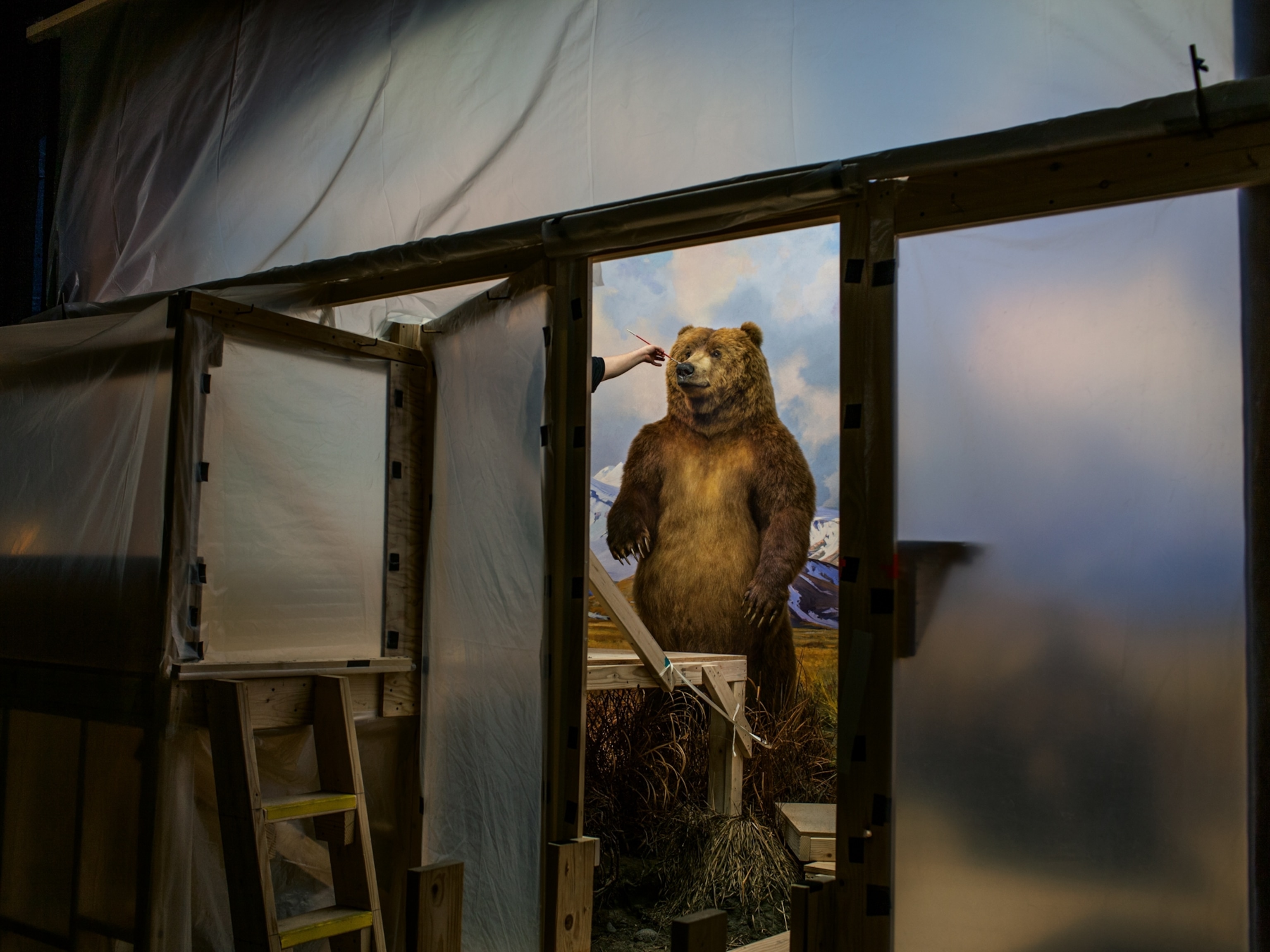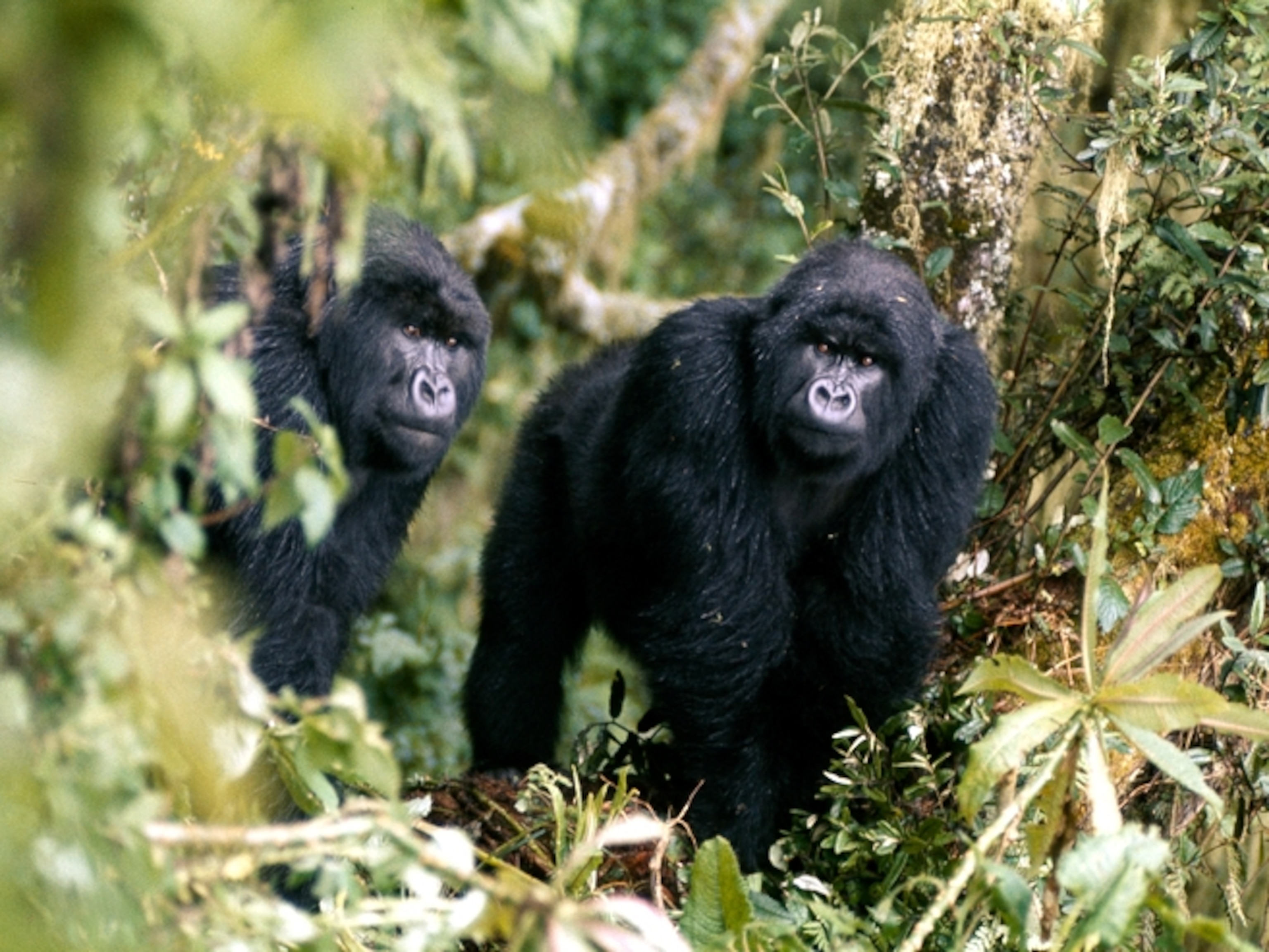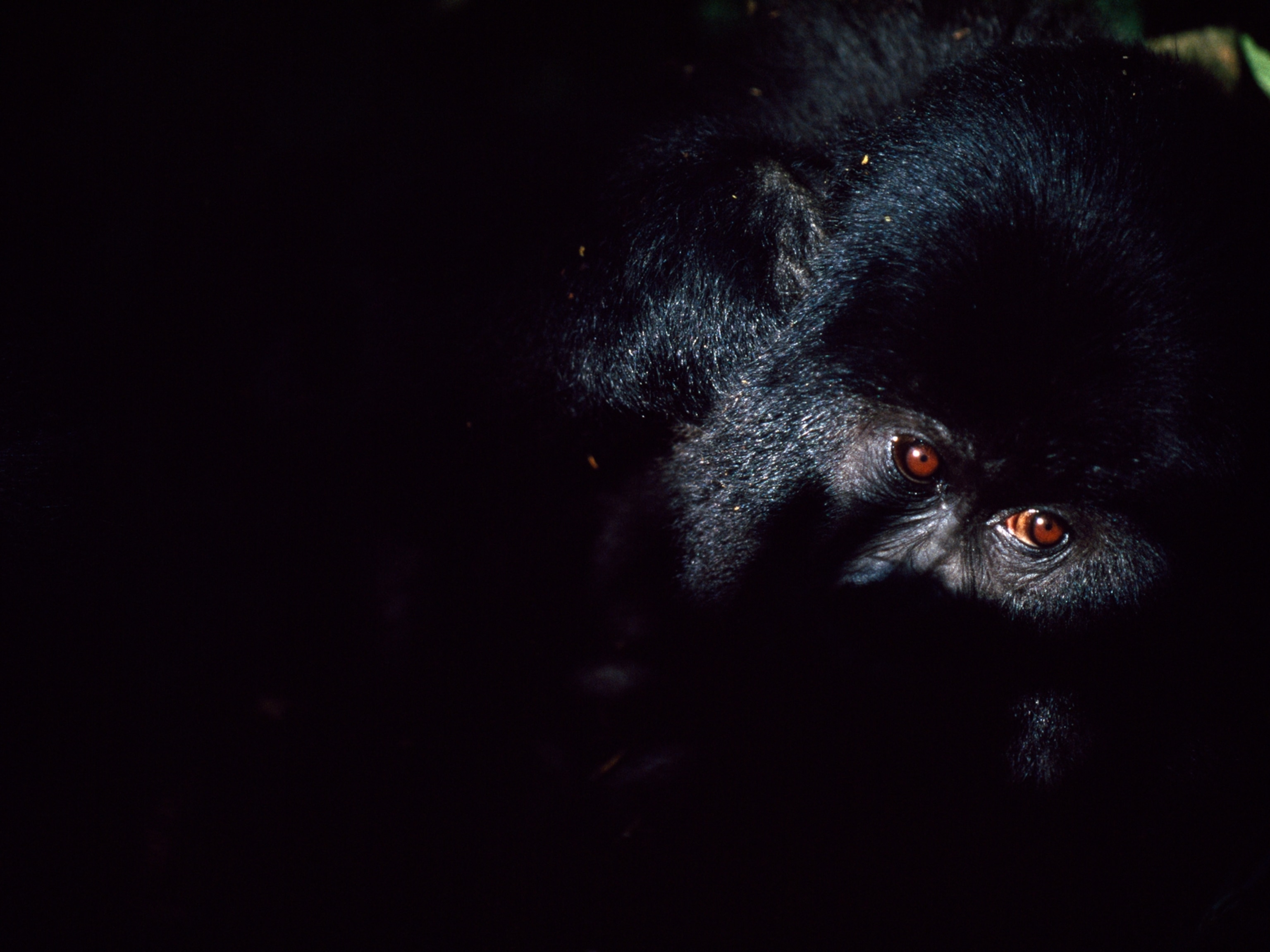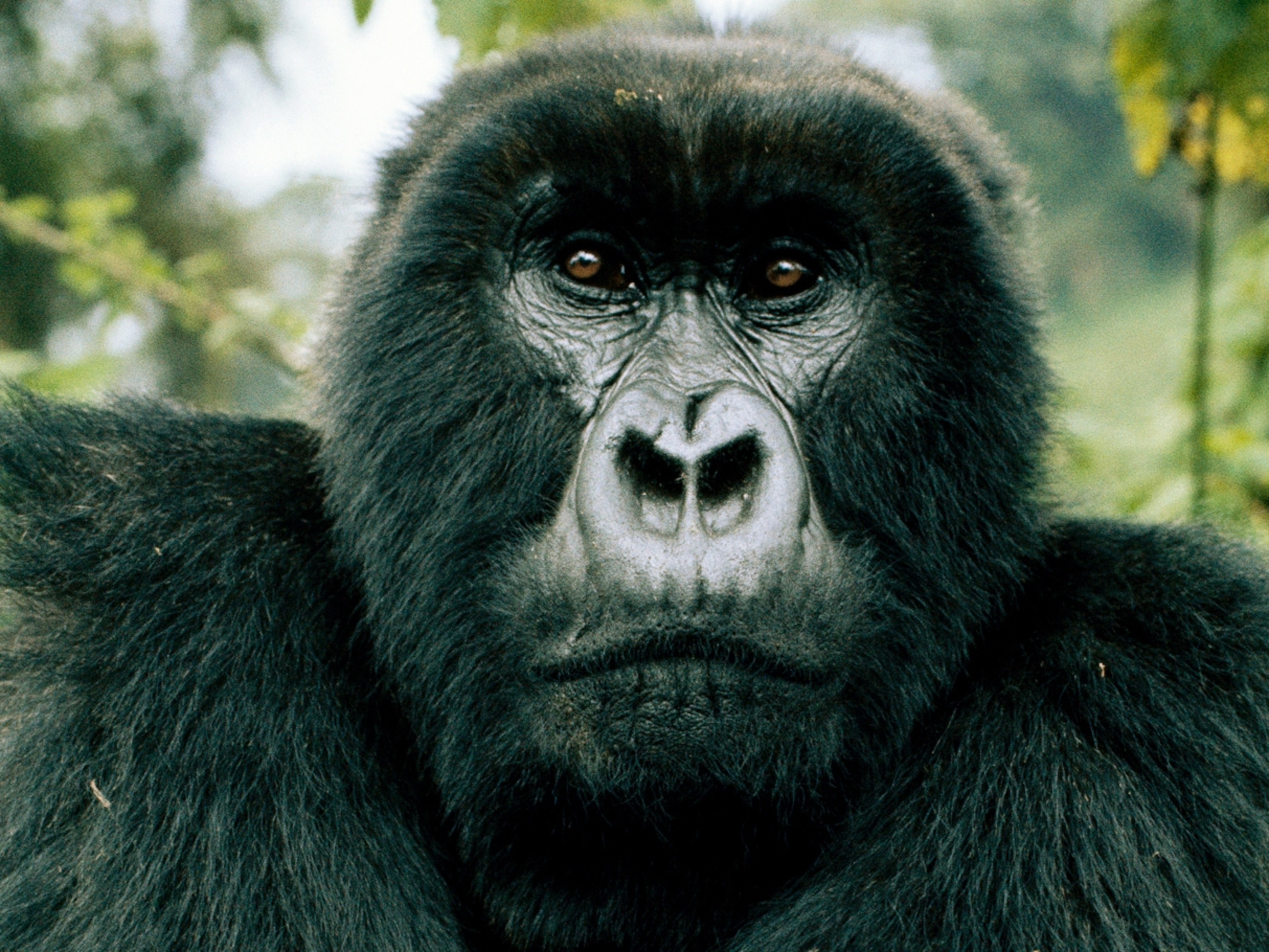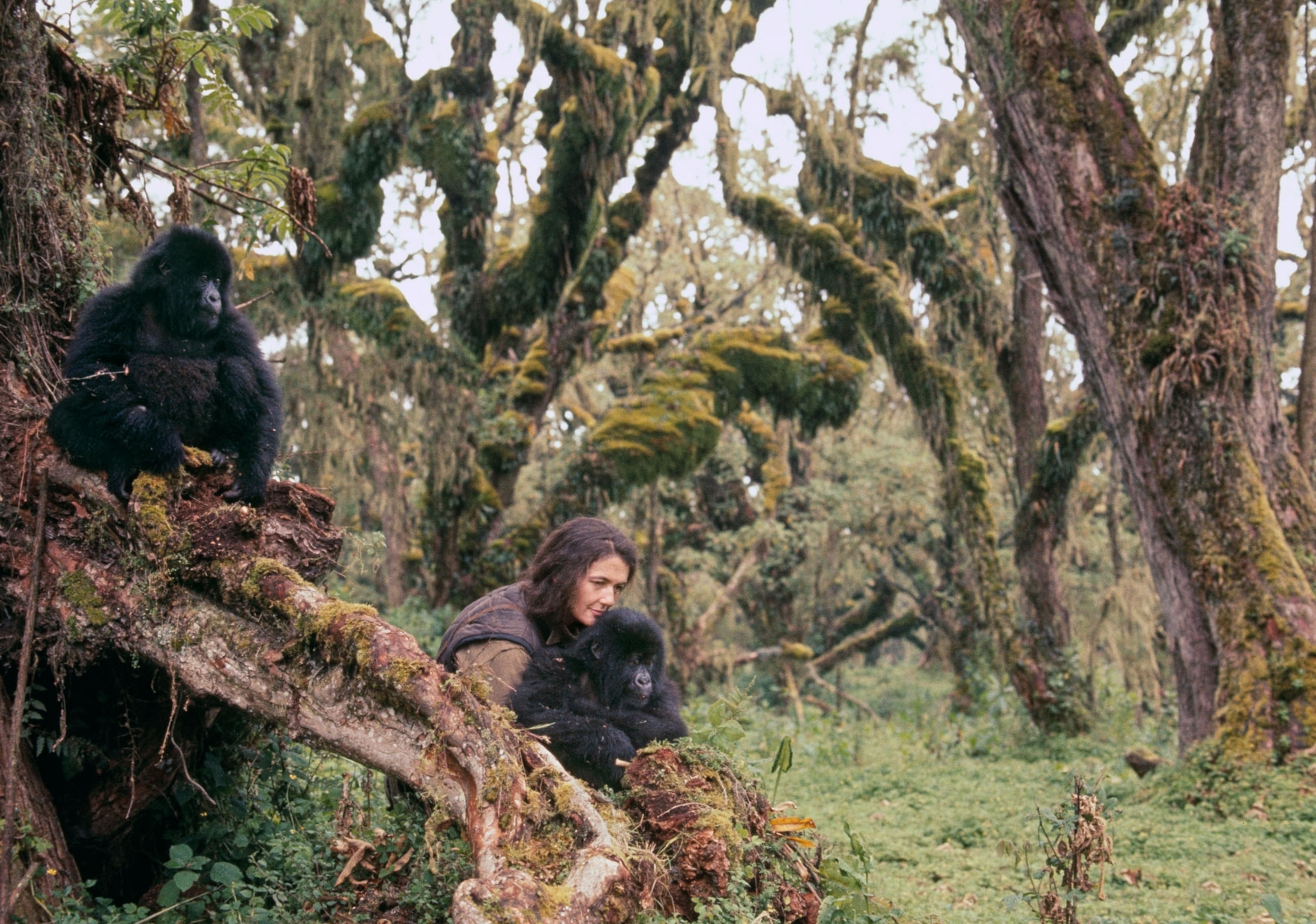
The Gorillas Dian Fossey Saved Are Facing New Challenges
Three decades after the groundbreaking researcher was killed in Rwanda, the ape population is growing—but is under rising pressure.
This story appears in the September 2017 issue of National Geographic magazine.
Shortly after dawn two mountain gorillas swing gracefully over the shoulder-high stone wall that borders Volcanoes National Park in northwestern Rwanda. Landing lightly on cropped grass, the silverbacks stroll downhill through cultivated fields—knuckle-walking at first, then upright on two legs. The adult males belly up to eucalyptus trees and score the bark with their incisors. Then, joined by females and juveniles from their group, which researchers call Titus, they advance on a spindly stand of bamboo.
Later that morning Veronica Vecellio, the gorilla program manager for the Dian Fossey Gorilla Fund International, settles onto a log inside the park, high on a thickly forested, mist-shrouded slope of the Virunga Mountains, and turns her attention to a silverback known as Urwibutso. A frequent wall hopper, Urwibutso is carefully folding thistle leaves before placing them in his mouth. When he turns toward Vecellio, an ebullient woman who studies gorilla group dynamics, she snaps a picture, then zooms in on a wound on his nose.
“He fought with another silverback from Titus this morning,” she whispers intently. (Silverbacks get their name from the white hairs that blanket males, saddlelike, when they reach maturity.)

The Titus group has been sneaking over the park wall for 10 years, Vecellio says, and each year it ventures farther. The situation isn’t ideal. Gorillas don’t eat the potatoes or beans that villagers plant—not yet. But they do kill trees, a valuable resource, and come into close contact with human and livestock waste, which is loaded with pathogens. The potential for disease spillover between species is high, and the chance gorillas could survive a virulent outbreak is low. So when the Titus group gets within a stone’s throw of the mud-and-stick homes of Bisate, a village of about 10,000 people, park guards waving bamboo poles slowly shoo them back uphill. Vecellio sighs. “This is the price we’re paying for success.”
Dian Fossey, an American with no experience researching wild animals, arrived in Africa to study mountain gorillas in the late 1960s at the urging of anthropologist Louis Leakey and with financing from the National Geographic Society. By 1973 the population of these great apes in the Virunga Mountains had fallen below 275, but today, thanks to extreme conservation measures—constant monitoring, intensive antipoaching efforts, and emergency veterinary interventions—there are now about 480.
More gorillas have been a boon for genetic diversity: For years, researchers have documented evidence of inbreeding, such as cleft palates and webbed fingers and toes. But the population uptick has a downside. “Group sizes are larger,” Vecellio says. The Pablo group hit 65 members in 2006; it’s now down to about 25—still almost three times as large as average gorilla groups in the Virunga Mountains in Uganda and the Democratic Republic of the Congo. “The density of groups in certain areas is also up,” Vecellio adds.
Clashes between groups, which raise the odds gorillas will suffer injuries or commit infanticide to wipe out a competing male’s genes, are six times as frequent now as 10 years ago. “We’re seeing an increase in the level of stress too,” Vecellio says, and possibly increased exposure to stress-related diseases.
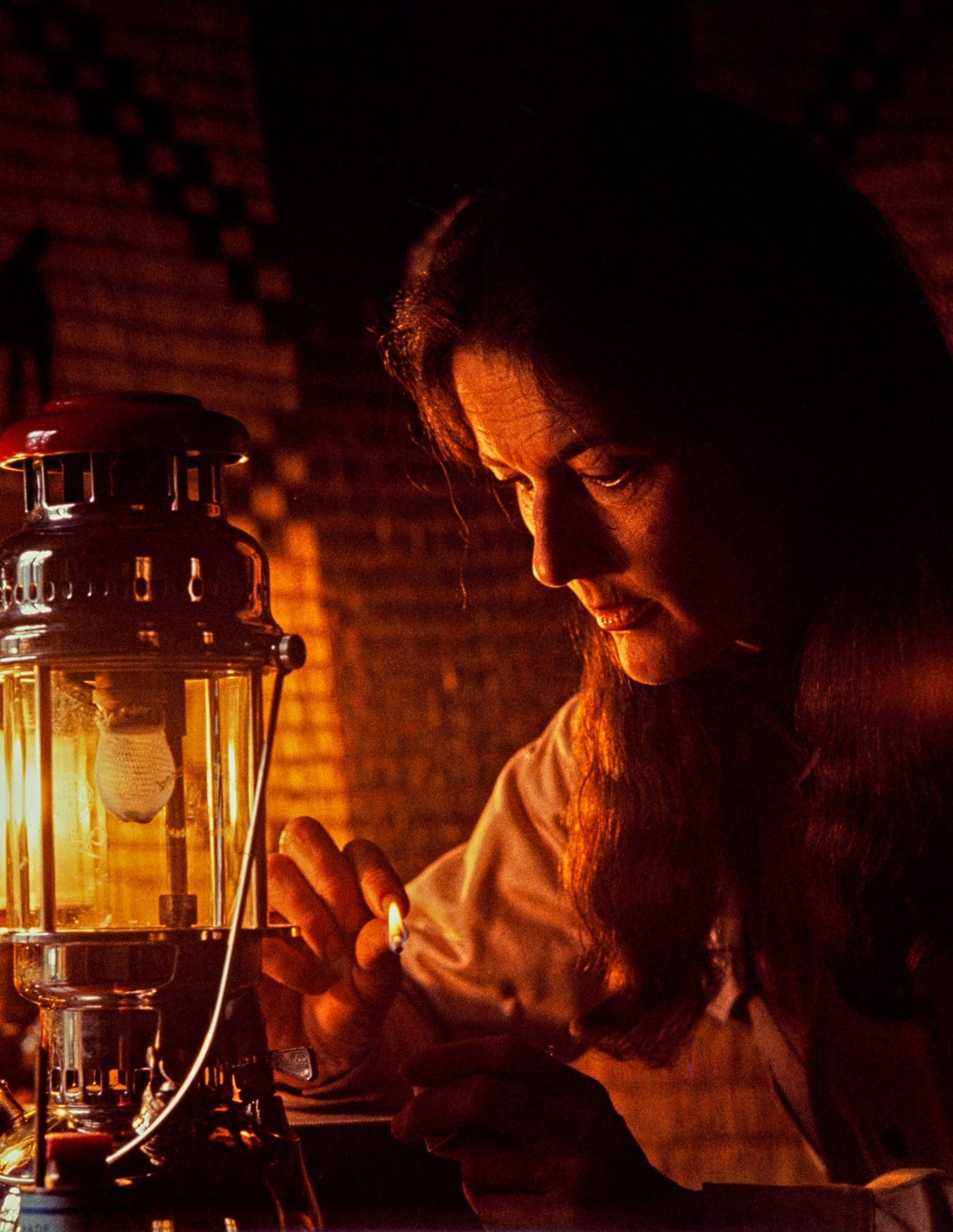
These problems would not be so acute if the mountain gorillas had unlimited room to roam. But Volcanoes National Park is just 62 square miles, and a rising sea of humanity, hungry for more farm and grazing land, laps at its boundary. Villagers routinely flout park rules and clamber over the stone wall to cut firewood, hunt meat, gather honey, and in the dry season, collect water.
From the morning’s eucalyptus and bamboo raid, it’s obvious the Titus group is comfortable outside the forest. But the gorillas have little immunity to human diseases, and their blasé attitude toward people leaves them vulnerable.
Such dynamics are largely hidden to the park’s visitors. Researchers who study Rwanda’s mountain gorillas, however, understand that they’re documenting a unique moment—not only the increase in population of a critically endangered species but also the possible revision of the rules assumed to govern its social behavior.
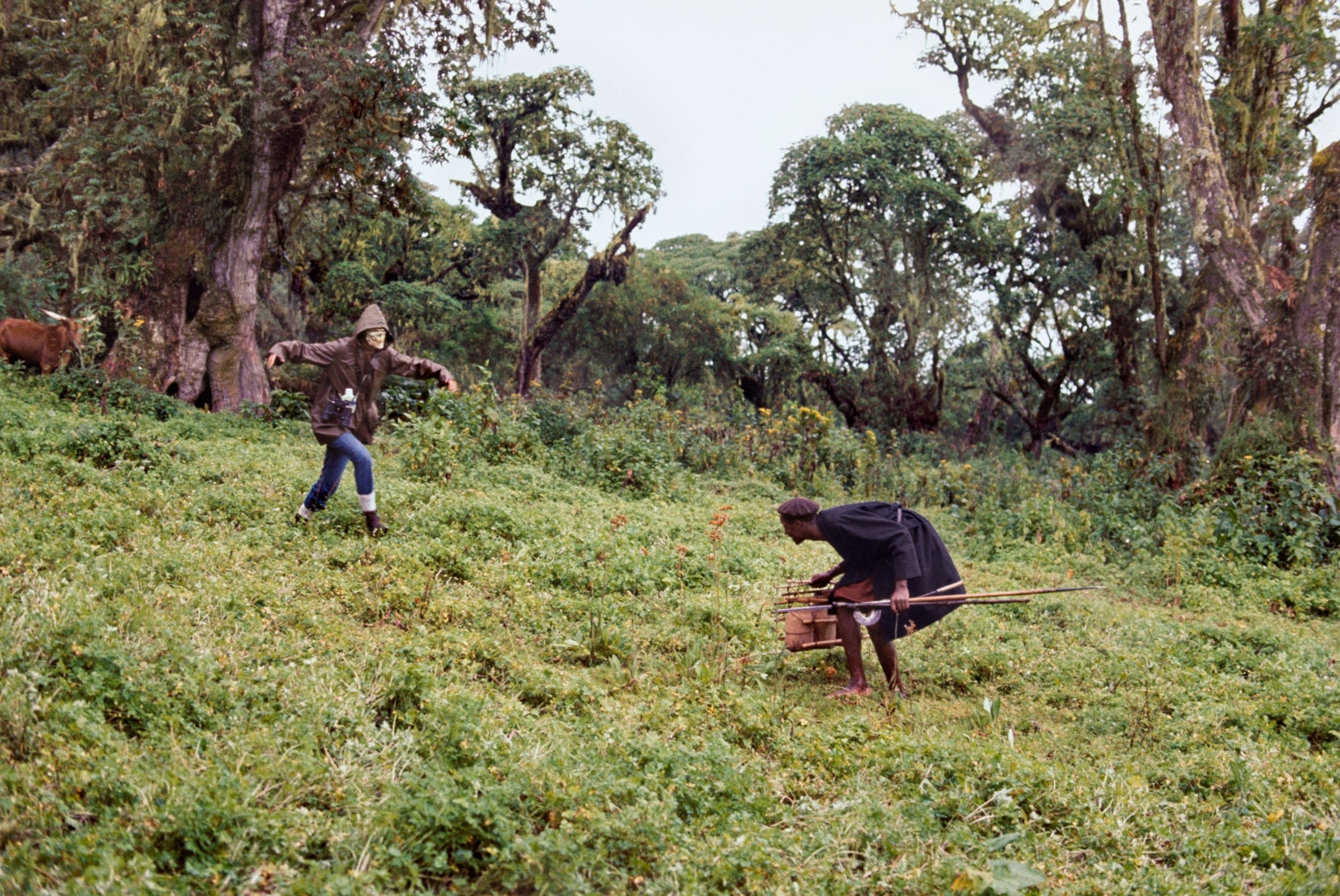
On an overcast morning, with temperatures in the mid-50s, it takes me nearly two hours to hike from the outskirts of Bisate through calf-deep mud and shoulder-high nettles to the research site established in 1967 by Fossey in the high-elevation saddle between Mounts Karisimbi and Visoke. The camp, which Fossey named Karisoke, began with two tents and grew to include more than a dozen cabins and outbuildings in a grove of moss-shrouded Hagenia trees, 80 feet tall. Today, as in Fossey’s day, a profusion of ferns, vines, and grasses seems to tint the humid air green, and a stream flows past the clearing. When the corpse of an infant gorilla disappeared, Fossey spent countless hours hunched on this stream bank examining adult dung for irrefutable evidence of cannibalism, but she never found it.
After an intruder murdered Fossey in her bed in 1985—a crime that remains a mystery—researchers continued to work at Karisoke. The camp shut down in 1994 during the Rwandan genocide, and rebels traversing the forest ransacked it. Today the much expanded Karisoke Research Center operates out of a modern office building in nearby Musanze, and the only man-made traces of Fossey’s site are foundation stones and the occasional stovepipe.
Despite the climb, drenching rains, and temperatures that can drop into the 30s, some 500 pilgrims a year trek to Karisoke to pay tribute to Fossey. Many know her from her book Gorillas in the Mist, which inspired the 1988 movie. On my visit, though, I have the place mostly to myself. As I explore the grounds, trying to imagine Fossey’s life here, porters quietly scrape lichen from the wooden signs that mark the graves of 25 gorillas. Just outside this rustic cemetery, a bronze plaque rises over Fossey herself.

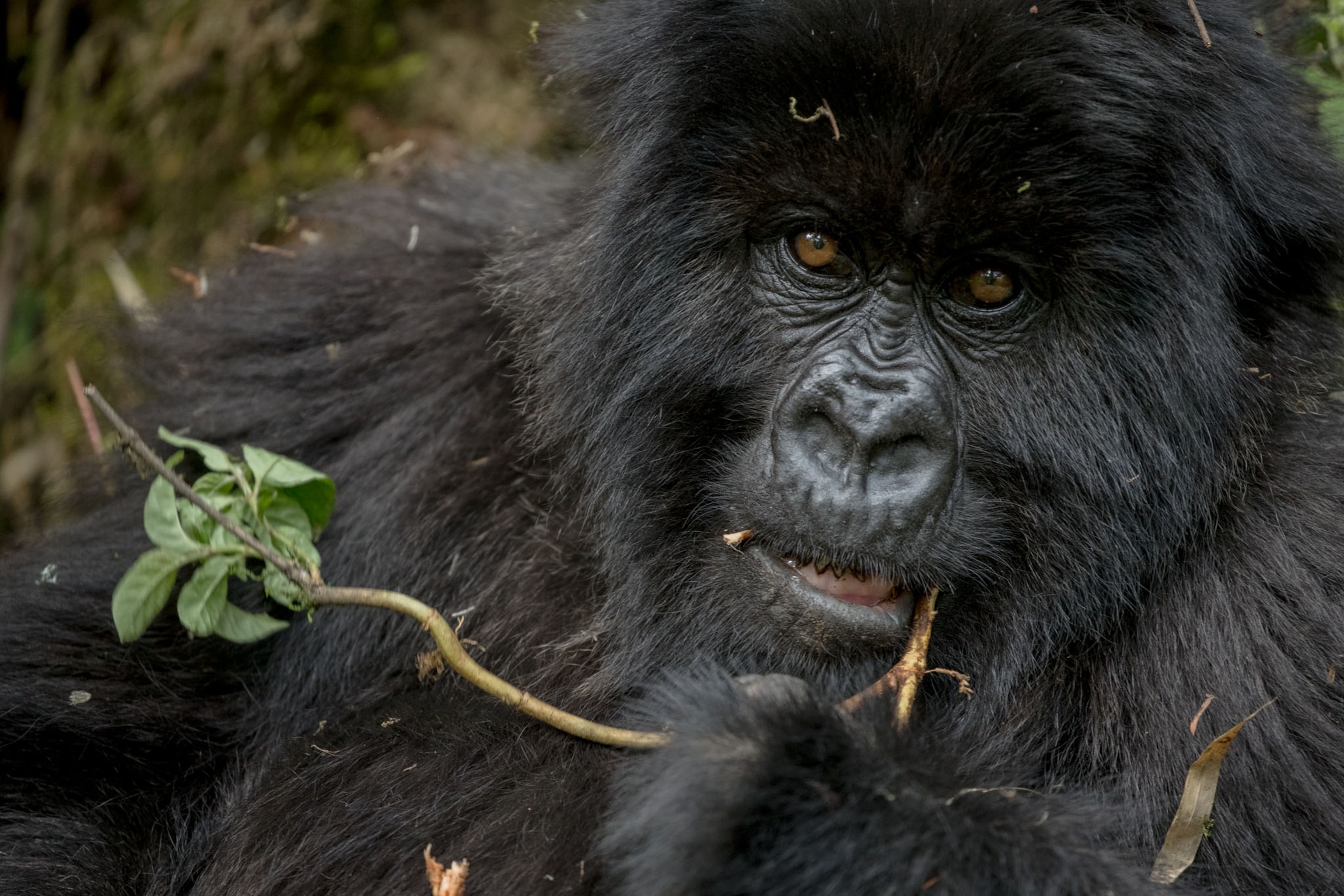
The tall, outspoken Fossey was not universally beloved. Many locals considered her an interloper or a witch, who not only confounded cultural norms but also presented an existential threat to those who depended on the forest for sustenance. From the start, Fossey made clear her priorities. She chased herders and their cattle out of the park: The animals trampled the plants that gorillas favored and forced them upslope to temperatures they couldn’t withstand. Every year she destroyed thousands of traps and snares intended to catch antelope and buffalo. The snares didn’t kill gorillas outright but often pinched off limbs that became gangrenous or fatally infected. Fossey captured and beat poachers with stinging nettles, burned down their huts, confiscated their weapons, and once even took a poacher’s child hostage. But her most effective tactic—and an enduring part of her legacy—was paying locals to patrol the park and insisting that Rwandan authorities enforce antipoaching laws. Fossey was a polarizing figure, but as Jane Goodall, the chimpanzee expert, once said, “If Dian had not been there, probably there might have been no mountain gorillas in Rwanda today.”
Contemplating the simple plaque on Fossey’s headstone, I’m struck by all that was extraordinary about this pioneer: her 18 years in the forest, her epic battles for funding, and her struggles for academic legitimacy, physical health, and emotional connection. It’s beyond irony that Fossey showed the world a largely peaceable realm of affectionate gorilla families, while her own life was characterized by bitterness and mistrust. “She was alone and hated by many,” says Vecellio, who describes herself as a lifelong Fossey “superfan.”
Fossey’s grave lies just a few steps from that of Digit, the silverback whom she reluctantly turned into a fund-raising bonanza—by creating the Digit Fund—after he was stabbed and decapitated by poachers. Fossey was desperate for money to pay her trackers and antipoaching teams. But she hated the idea of generating revenue from ecotourism, and she considered gorilla tourists—who began arriving at Karisoke, against her wishes, in 1979—a driver of gorilla extinction. And yet it was Fossey’s knack for publicizing her studies through lectures and articles that turned the gorillas into causes célèbres. It was also Fossey who figured out how to habituate gorillas to humans, without which the tourist trade wouldn’t exist.
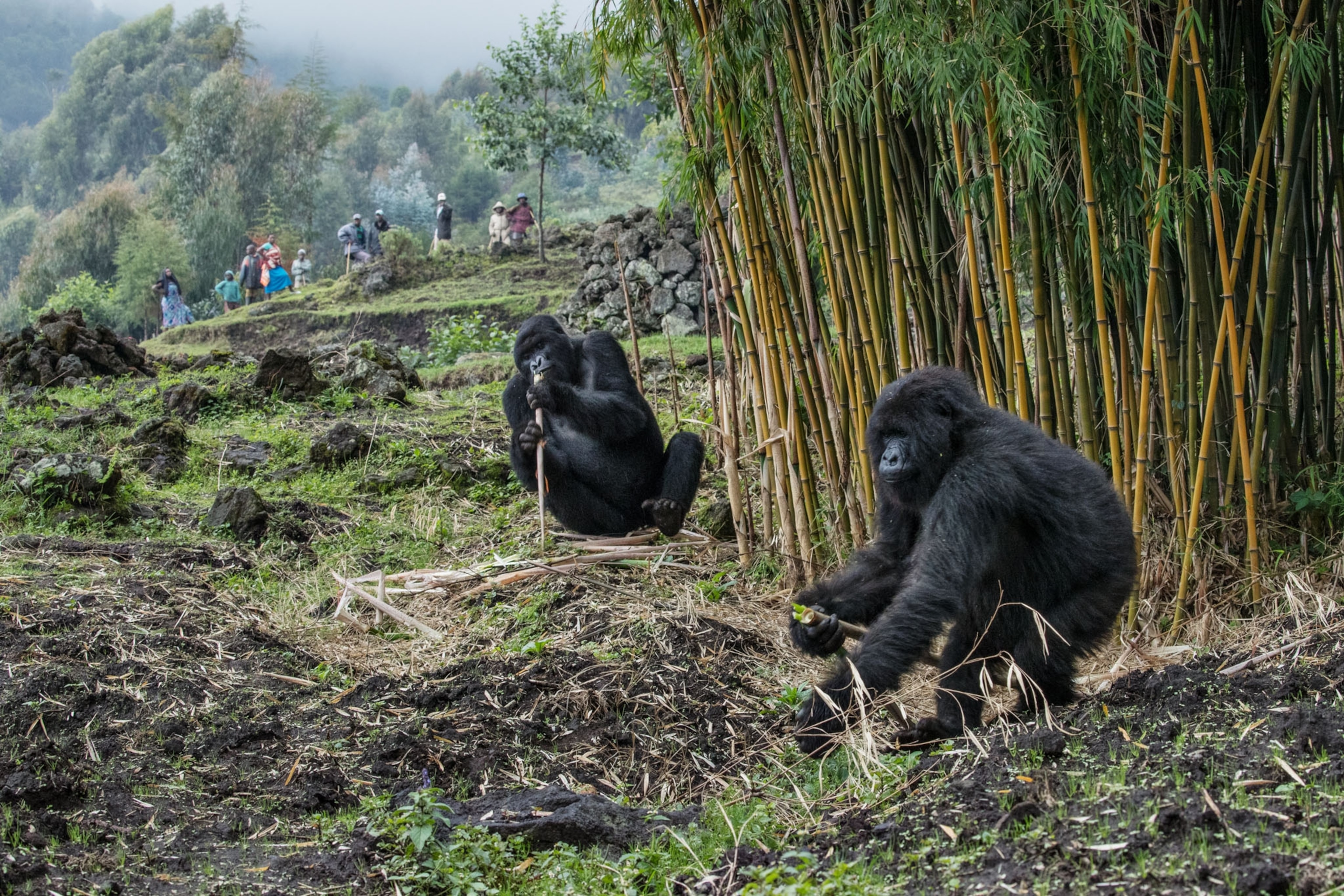
Rwanda barely tolerated Fossey when she was alive—authorities repeatedly denied her visa applications and stymied her efforts to halt poaching. But the country was quick to realize that her death and burial within a national park, Vecellio says, “had enormous symbolic value. It created a sense of urgency and brought international support for gorilla conservation.” Last year more than 30,000 people hiked into the park, each paying the Rwanda Development Board, which oversees the nation’s tourism, $750 for a gorilla-group encounter limited to one hour. The fees, which recently jumped to $1,500, pay for security and monitoring, and they ensure the government’s commitment to protecting the species.
For the safety of animals and humans, the development board allows only eight people in each trekking group. But with more groups of gorillas, more visitors than ever can have their primal moment. Higher visitation means more money is funneled, through a revenue-sharing plan, into local communities, and it creates ripple opportunities for businesses. During the high season, tourists fill more than 20 hotels and guesthouses in and around Musanze—the town had just one when Fossey arrived—generating income for drivers, housekeepers, waiters, chefs, bartenders, guards, farmers, park guides, porters, and trackers.
Tourism opportunities may expand even more. The Rwandan government, in collaboration with the Massachusetts Institute of Technology, is considering the construction of a climate research station on the summit of Mount Karisimbi, at 14,787 feet. A cable car would whisk scientists to their instruments and tourists to crater-top zip lines. Worried that the project could destroy gorilla habitat, conservation groups are calling for a comprehensive study of its environmental impacts.

It's late morning before my guide locates the Sabyinyo group, a short hike from the park boundary, through a dim bamboo forest. As the rain that has been pelting lets up, we hear the animals—stripping and munching the scenery—well before we spot them. A mountain of muscle, the silverback Gihishamwotsi sits in a clearing of crushed ferns and giant lobelias, calmly overseeing a harem of females and their babies. Now and then he grunts, eliciting guttural responses from gorillas just out of sight. When he rises suddenly to beat his chest, he gets more of a reaction—alarm—from me than from anyone else.
I’d suspected that a lifetime of watching nature documentaries and knowing that gorillas and humans share 98 percent of their DNA would diminish the thrill of seeing these animals in the flesh. But from six feet away, I’m dumbstruck by that flesh: the babies’ feet, as smooth and meaty as yams, the mothers’ kielbasa-size fingers, the silverback’s forearms, which resemble muffs fit for giants. I’m entranced too by the familiarity of their gestures: Like us, they scratch! They play with their toes! They hug their babies to their faces! On the heels of this epiphany, however, comes guilt—for intruding upon their privacy.
When my hour is up, I dash down the mountain to meet Winnie Eckardt in a small room in the Karisoke Research Center. Leaning against a freezer, the research manager gestures to the trove of frozen samples at her back. “Welcome to the poop lab,” she says with a grin. Eckardt, who jumps at any chance to summit the nearby volcanoes, has been studying mountain gorillas since 2004 and now supervises the monthly collection and processing of fecal samples—which contain hormones, enzymes, and DNA, in addition to viruses and parasites—from 130 animals. (Disposable bags are a key component of ranger gear.)
“Wildlife endocrinology is an increasingly significant field,” Eckardt says, “and it’s a very powerful tool.” Karisoke researchers are extracting from gorilla feces the stress hormone cortisol and correlating it with observed interactions. “Now we can say this or that type of interaction is causing stress,” she says.
In 2014 researchers compared observations on demographics and behavior in gorilla groups with genetic analyses of DNA extracted from fecal samples. Their results shed light on key differences between how far males and females disperse from their natal group—one of the main factors that determine a population’s genetic structure.

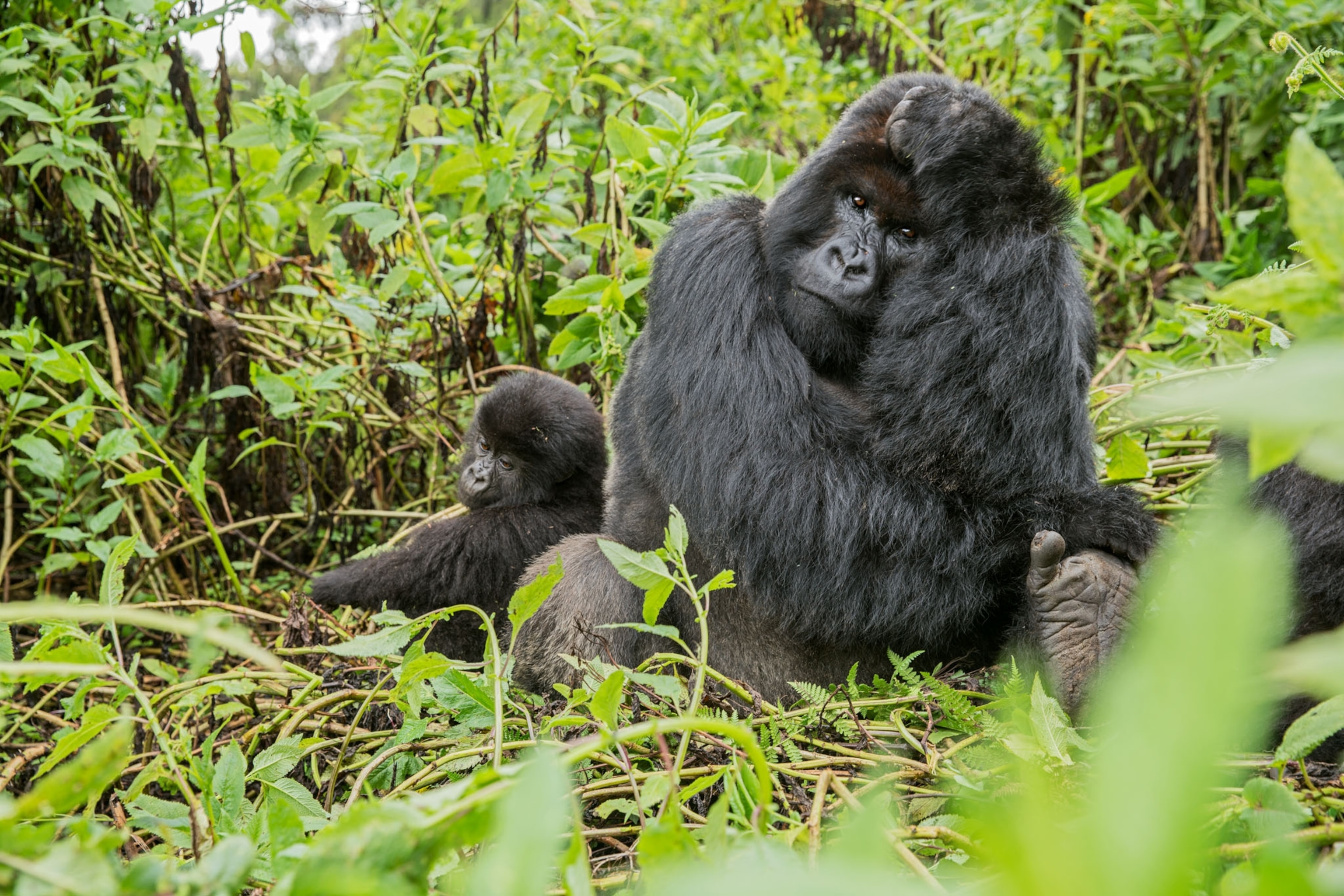
DNA sequencing is also telling researchers about gorilla paternity. “From these studies we’ve learned that the dominant silverback is the father of most babies in a group but not all,” Eckardt says. The number two and three silverbacks are also passing on their genes. This raises more interesting questions: How do nondominant silverbacks decide whether to stay in a group or to try to seduce females into establishing a new group? What factors are linked with reproductive success? How do you stay number one? “There is a lot of competition out there,” Eckardt notes.
By revealing evidence of inbreeding and the success of various family lineages, DNA analysis also informs conservation decisions. “If managers can save only a few groups of gorillas,” Eckardt says, “you want to choose groups that are distantly related. If they’re inbred, they won’t behave normally or may have health complications, which you may need to monitor differently.” Less genetic diversity also means gorillas are more vulnerable to disease and to climate-change disruptions.
Researchers have published nearly 300 papers based on data collected at Karisoke, but there’s still much to learn. “If you’d done a study from 1997 till 2007, which is a long study,” says Tara Stoinski, president and chief scientific officer of the Fossey Fund, “you’d think there was no infanticide here. But we know, from before and after that period, that it’s not an uncommon behavior.”
Through the 1970s gorillas lived at low densities with a lot of human disturbance—like poaching and cattle herding—which shattered groups and drove lone males to lure females from their groups, then kill their babies to trigger estrus. As poaching declined, so did infanticide. “Now we have a high density of groups and low human disturbance,” Stoinski says, “and infanticide is up because of increased intergroup interactions. It’s fascinating to see how the gorillas react.”
Perhaps one of the biggest surprises to park officials and Stoinski, who has published nearly a hundred papers on primate behavior and conservation, was the reappearance in January of a silverback presumed dead. Cantsbee, one of the last two gorillas named by Fossey, was the longest lived male recorded by researchers. He reigned over Pablo, Karisoke’s largest group, and according to an analysis that ended in 2013, fathered at least 28 babies—a record among studied gorillas. After the rufous-browed legend disappeared last October, at the age of 37, scores of trackers spent a fruitless month scouring the forest for his body. Finally, the Fossey Fund published an obituary, noting that he was born during a time of intense poaching but lived to a ripe age thanks to conservation measures.
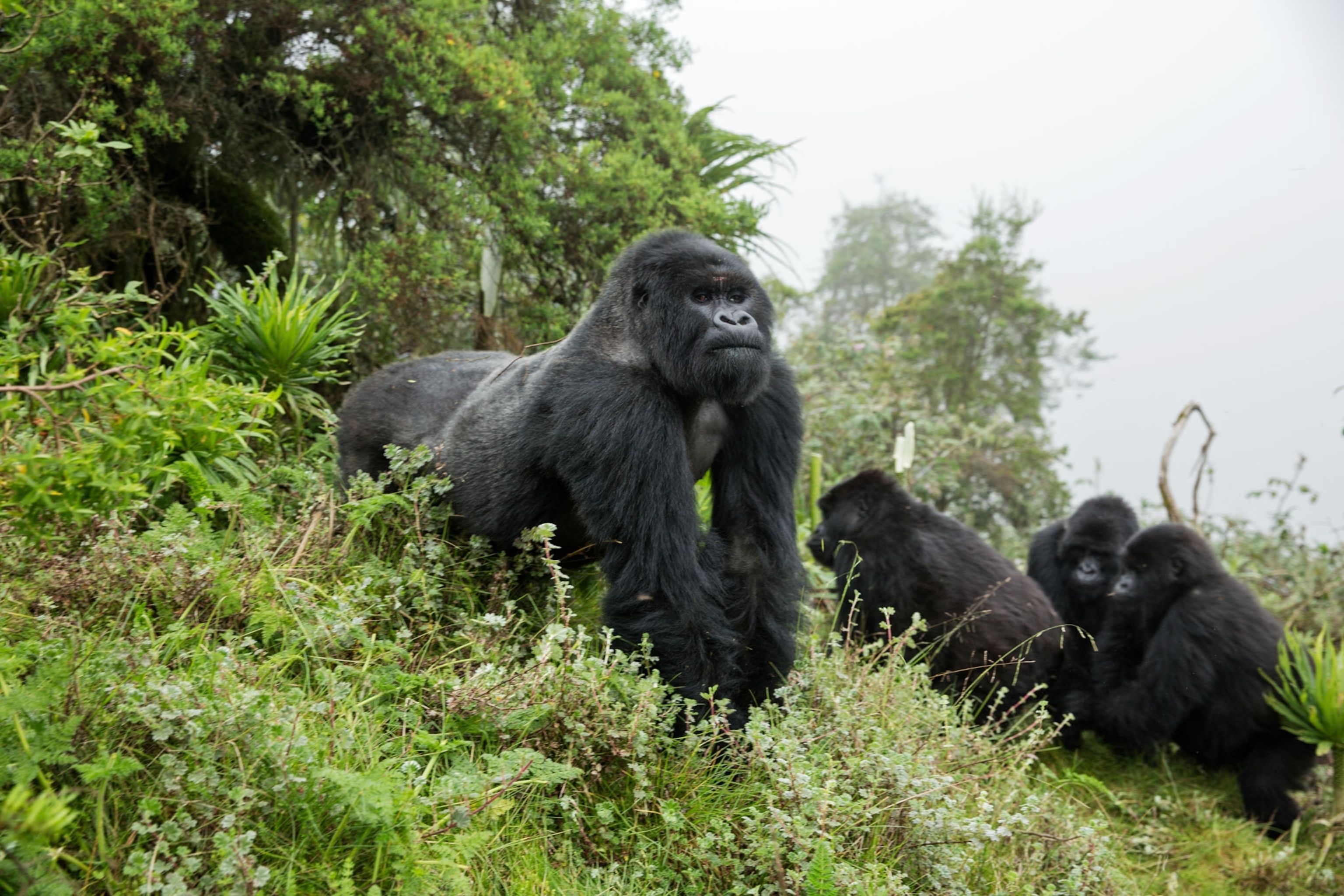
Cantsbee’s return upended many assumptions about dominant male behavior. “For a leader of his age and status to go and then come back—that’s never been seen,” Stoinski says, with a note of wonder. “Plus, he looked great—superfit.”
In Cantsbee’s absence his son Gicurasi had become Pablo’s leader; upon his return Cantsbee sometimes led the group but by no means dominated. Then, in February, looking weak, he slipped away for the last time. His body was found in May.
To Karisoke researchers, everything happening in the park today demonstrates how flexible mountain gorillas, like most big-brained primates, can be. In Fossey’s time, groups under observation contained just two or three males. In the 1990s and early 2000s when human interference declined, groups grew considerably in size and had as many as eight silverbacks. More recently researchers have observed many group splits, often after the death of a dominant male, resulting again in groups that look more like those of Fossey’s time. “This shows us that behavior doesn’t exist in a vacuum. It depends on a larger context,” Stoinski says. “As their environment and circumstances change, so do things like gorilla social organization.” And because gorillas take a long time to mature, it takes long-term studies to even hint at what “normal” means.
While human activities are propelling about 60 percent of wild primate species toward extinction, one great ape population is rising. Even so, the mountain gorillas of the Virungas are still vulnerable. “The population is incredibly small and fragile,” Stoinski warns.
And so the Fossey Fund continues to monitor animals and help remove snares, even as it invests in social programs. The organization created a school library and computer center in Bisate, where it also built a maternity ward; it runs conservation education programs that reach about 13,000 Rwandans a year; and it plans to help villagers find ways to make a living that don’t include scrambling over the park’s stone wall.
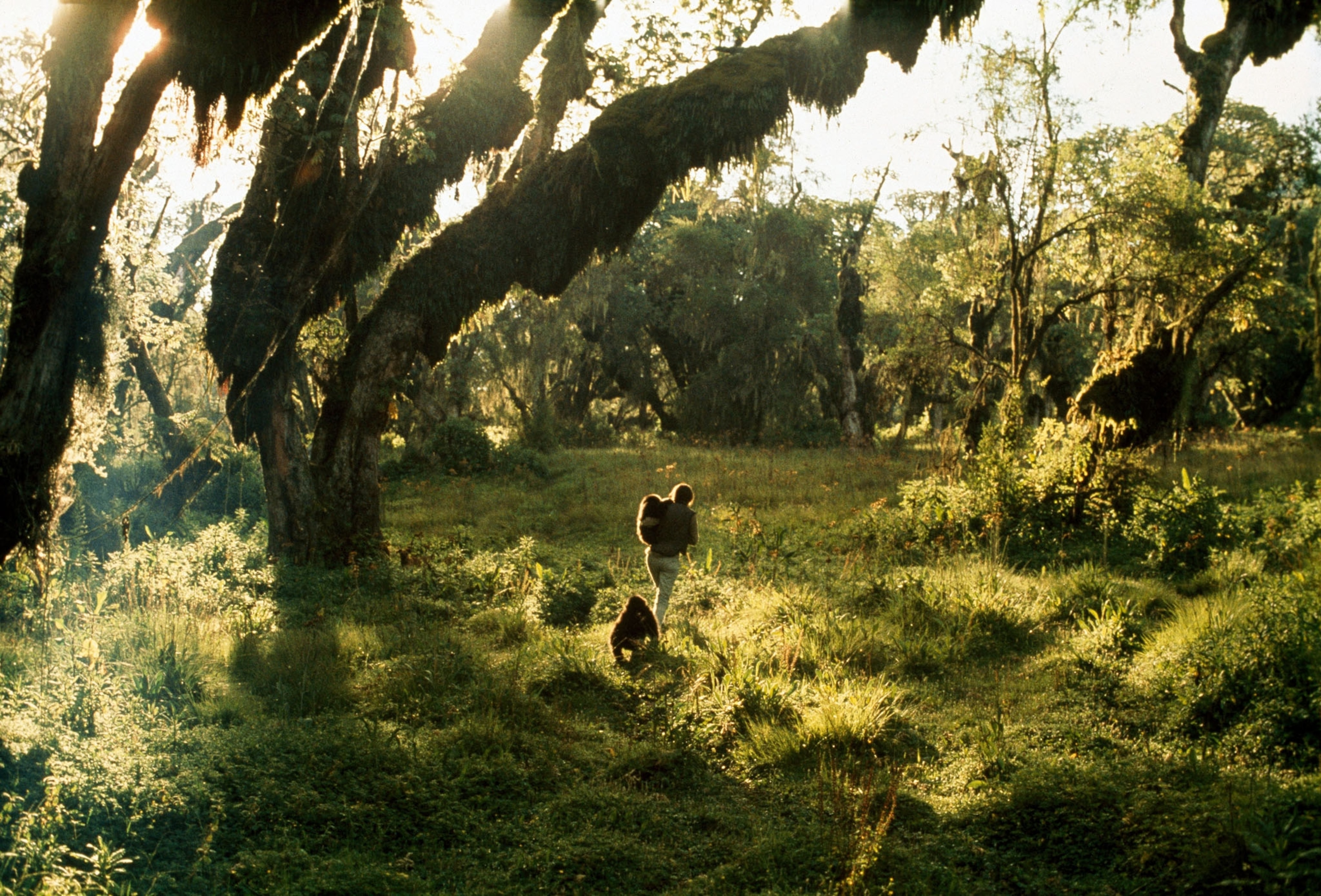
Gorillas are already shifting into areas of the park with fewer groups. But humans may need to cede land to gorillas too. The government has proposed a buffer zone that would force people, their livestock, and their farm plots farther downhill. That would be enormously controversial, since 1,813 people per square mile call Musanze District home. “We need to make sure that the communities understand the value of the park,” Stoinski says. After all, gorilla trekking is the mainstay of the nation’s tourism industry, which brought in $367 million in 2015, and the park shares 10 percent of its revenue with local communities.
Watching a mother gorilla dandle a tiny puff of an infant while a pair of adolescents wrestle on a mattress of vines, it’s easy to forget the human gymnastics that make such a delightful tableau possible. Critics ask whether these extreme conservation efforts consume money that might better be spent on other species, and some have suggested they may even disrupt natural selection by helping less fit individuals survive.
But Vecellio steadfastly defends the work. “We are keeping these gorillas alive, reversing the human impacts,” she says, “because it’s humans who have made them endangered.”

